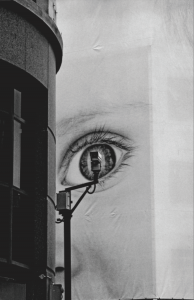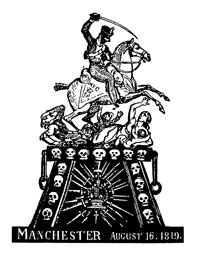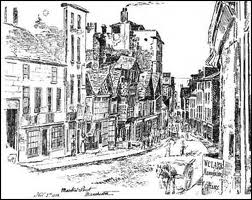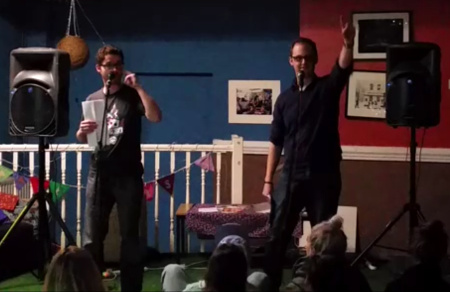When are we?
Article published: Wednesday, June 1st 2011
Tim Hunt is given a tour of Manchester with a difference by Morag Rose of the Loiterers Resistance Movement.
 I meet Morag in the Cornerhouse cinema on Oxford Road, central Manchester but we don’t stay at this all-too-comfortable art-house venue for long. Morag has agreed to take me on an unofficial tour of the city. She is part of the Loiterers Resistance Movement (LRM), a Situationist-inspired ‘psychogeography’ group that roam the city sharing knowledge and emotional experiences of the ever-changing urban landscape.
I meet Morag in the Cornerhouse cinema on Oxford Road, central Manchester but we don’t stay at this all-too-comfortable art-house venue for long. Morag has agreed to take me on an unofficial tour of the city. She is part of the Loiterers Resistance Movement (LRM), a Situationist-inspired ‘psychogeography’ group that roam the city sharing knowledge and emotional experiences of the ever-changing urban landscape.
We leave the Cornerhouse and head onto Oxford Road, one of the busiest and best-known streets in Manchester. But in true Loiterers style we quickly leave it and head down an old cobbled side street. Among the gaudy new façades of the bars that line the street sits an ornate door way dating from the 1920s and some superb graffiti. This is first example of what Morag describes as “resonances” – the blurring between the past and the present. History she says “is not linear… things seep out of the past into the present.” These resonances are what the LRM is all about. Their aim is to connect people with them, to give individuals a better sense of their environment, themselves and others.
But what’s at the end of the road is what she really wants me to see. It’s a plaque commemorating Little Ireland, one of many slums that defined 19th century Manchester. “These places still exist” she says “we’ve just globalised them”. Despite her eagerness to point this out Morag is clear she doesn’t want to fetishise the bleak conditions that were prevalent here, but nor does she want to ignore stories that are often hidden from the official histories of Manchester and other industrial cities. “There was one toilet here for 400 hundred people,” she says grimacing.
Unofficial histories
She rails against the official narratives often told on the heritage tours of Manchester, “I want to complicate the official narrative and deviate from the official tour. For me the city is about multiple narratives, diversity and personal history.
“The dominant narrative is one of triumph [of the industrial revolution], they never talk about the squalor… On one official walk they don’t even mention the Pankhursts,” (the famous suffragette sisters) she tells me, while “they never mention the Burns sisters.” I look at her blankly revealing my ignorance. “They were companions of Engels… and helped [him] gain access to the slums while he was writing about and living in Manchester. A dandy like him couldn’t just walk in there, he would get killed.”
She describes the official history of Manchester, the one the council and its PFI marketing companies and development agencies espouse, as “narrow”. She explains: “You get the industrial revolution and then the IRA bomb and the redevelopment that followed… it’s as if there’s nothing in between. But lots of things are happening all at the same time.”
The LRM try to piece these lost stories together by interacting with the city and other people. She continues, “They paint it as the original modern city but you don’t have to look far to find the abandoned regeneration projects or the homelessness… I’m for progress, the city has to change, but regeneration has to be for people not just for money.” She adds that “there are many different forces that make the city – it is about how we can interact with them.”
We continue our walk crossing Whitworth Street and then heading through an alley way and onto the path alongside the canal, another clear link to the past. We walk between new flats and converted mills along the cobbled tow path. This is one of Morag’s favorite places, one of the few areas in the city that’s free from the constant bombardment of advertising. However we are, it seems, constantly watched by CCTV. “We asked for the footage once after walking down here, but most of the cameras were turned off.”
Eyes down
 Morag tells me how the LRM plays a game called CCTV bingo. They walk in the gaze of one camera until they find another. “It’s sooner than you think.” This game-playing is central to the LRM. “It’s silly and fun…but such games help to give you an emotional relationship with the city ”
Morag tells me how the LRM plays a game called CCTV bingo. They walk in the gaze of one camera until they find another. “It’s sooner than you think.” This game-playing is central to the LRM. “It’s silly and fun…but such games help to give you an emotional relationship with the city ”
In another exercise last year the LRM made an edible model of the city. “We took over 400 hundred photos of buildings around the city and then constructed them out of cake. It wasn’t topographically accurate,” she adds dryly. The cakes were then devoured in an afternoon. “The city is always changing,” she says with a smile.
We continue down the canal and walk by the old site of the famous Hacienda night club, “I’m glad it’s closed, it would be past its sell by date now.” This she says is another problem with Manchester. “It’s enthralled to a different era. The official narrative is that music stopped in year x.” Another reference to Tony Wilson’s defunct nightclub and the ‘Madchester’ subculture that it spawned, and that the city has traded off for twenty years.
We leave the canal path and head up to a modern musical landmark, the Bridgewater Hall. The site was previously home to Tommy Duck’s pub – famous, according to Morag, for having women’s knickers stuck to its ceiling. The redevelopment story of this site is typical of many in Manchester. A day before the notorious pub was due to receive its preservation order it was demolished in mysterious circumstances and against the wishes of locals. Working class pub makes way for classical concert venue: an allegory for much of Manchester’s redevelopment.
Private spaces
 We carry on past Peter’s Field, site of the Peterloo massacre and past the Free Trade Hall, once a public building, now a posh hotel. “Whenever a council space becomes vacant they never think about using it for the people, it’s always about making money,” says Morag. It was sold off in 1997, much to the annoyance of locals. However, due to a quirk in its planning application it is forced to open its doors to the public in order to view a mural depicting the Peterloo Massacre situated in an upstairs corridor. The LRM often like to pay a visit.
We carry on past Peter’s Field, site of the Peterloo massacre and past the Free Trade Hall, once a public building, now a posh hotel. “Whenever a council space becomes vacant they never think about using it for the people, it’s always about making money,” says Morag. It was sold off in 1997, much to the annoyance of locals. However, due to a quirk in its planning application it is forced to open its doors to the public in order to view a mural depicting the Peterloo Massacre situated in an upstairs corridor. The LRM often like to pay a visit.
We continue into Spinningfields, Manchester’s new financial district full of banks and high-end retailers (without any customers in them when we walked past). She tells me how rents are extremely low to get businesses to come here. It’s a space where people were asked by security not to take any photographs, not that there is much to photograph; it is all polished glass buildings and no character. But Morag remains optimistic. “Whatever the council do with places like this people will always adapt and appropriate them.”
We move through Spinningfields and head to our destination in redeveloped Castlefield. We pass a park, St Johns Gardens. “This was once a graveyard,” Morag tells me, “most of the green spaces in the city centre were. It’s a bit of a quirk. Angel Meadow [a park at the other end of town] is the site of a mass cholera grave.” Today’s overly-sanitised city is a far cry from its squalid past.
We end our walk at the OK Café. A temporary squatted social centre in a newish but disused council owned building, opposite the Science and Industry museum, in a heavily redeveloped area. The powers that be have long since abandoned Castlefield to invest in new parts of town. But as Morag said of the council’s latest plaything Spinningfields, “Whatever the council do with places like this people will always adapt and appropriate them.”
The LRM meet every first Sunday for some sort of wander around Manchester. It’s free and everybody is welcome. You can follow and contact Morag on twitter @lrm.
A version of this article was first published in the current (June / July 2011) issue of Red Pepper magazine
More: Culture, Exhibition, Features, Manchester
Comments
-
Your correspondent, Morag, is seriously mistaken about what is told on tours in Manchester.
First of all, there are no “official” tours of the city.
New Manchester walks provides a full programme of walks, including many on industry and politics, and we always do the squalor and horrors of Little Ireland in detail, as well as giving full credit to the Burns sisters.
Perhaps she should come on our tours before tarring all tour guides with the same brush.
Regards
Ed Glinert
Comment by Ed Glinert on June 1, 2011 at 9:51 pm -
Hi Ed
I’m very much aware of the good work done by new manchester walks – and yes, there are some excellent organised tours of manchester; i’ve been on several of them and am always learning more about the city. (i’ve also been on some terrible walks with ill informed guides but that is another story and not about you)
possibly some of the nuances of my thoughts are lost on the page but i was talking about – as tim says – narratives told by the council and marketing manchester etc. (a similar analysis of the dominant messages sent out is made by owen hatherley in the chapter on manchester in his “guide to the new ruins of briton”)
For the record I have been working on research comparing several (of the many) general walking tours of manchester; i selected them by the asking at the visitors information centre which they would recommend to somebody wanting an introduction to the town.
None of them mentioned the Burns sisters and one didnt think the Pankhursts worthy of note. They all follow remarkably similar routes as well. I’m happy to share my research with you when it is finished.
As i’ve said many times the city is made of many stories, most of them true.
The LRM are interested in complicating things and asking questions; we are not (and never claim to be) authorities on anything but our own experiences. I think that is clear from the article.I think we are actually on the same side here Ed, loving and exploring our city and the streets are big enough for us all. I would also extent an invitation to you to join us sometime and enjoy a different view.
best wishes
Comment by morag on June 2, 2011 at 1:19 pm
Morag -
Whilst there ARE serious questions to be asked about who decides what happens in this city (Mr Bernstein ususally, is the default)- andmore interestingly, ‘why’ these are never going to be seriously asked by people like Anna Minton (Ground Control)who simply guesses (at best) at whats going on, gets it wrong, and then argues with that, or from piffle like this and its ‘psychogeography’ and ‘situationism’ (sic). A more grounded and radical approach is needed if we are ever going to stop sleepwalking and take back control of this city. Its no longer ours but theirs.
Comment by B. Roger on July 5, 2011 at 12:20 pm
NB Morag – for example Spinningfields is a private development, not municipal, and its problem is that rents are stunningly high for what it offers (ask Halliwells – oops!) – that’s why it has been difficult to fill; if you don’t know don’t just make it up, luv. -
Hi Morag. I’ve been on one of your tours and very much enjoyed it. I’m also one of the Green Badge Guides and agree with Ed that there’s no such thing as an ‘official’ tour of the city. What we include in our walks is up to individual guides, so there will be some variation depending on the walk, the apparent interests of the guests, even the weather. On an introductory city walk it’s imposssible to cover everything. Sometimes I’ll mention Dylan and the Sex Pistols outside the Free Trade Hall, sometimes just one and sometimes neither, but I almost invariably cover the Pankhursts and the Sufragettes. I also cover the cotton famine when in Lincoln Square and Manchester’s role in the Anti-Slavery campaigns. The Burns sisters, or at least one of them, will usually get a mention as well, along the lines Morag has suggested. But sometimes the group’s intersts clearly lie in other dimensions of the city’s life and a few things will get dropped. The squalor is something I never ignore. By the way while there’s little in the way of major development currently taking place in Castlefield, the Castlefield Forum, a group of local residents and small businesses, is making progress in improving the area, often with the help of council grants, and is helping to develop a community spirit, not an easy task in a modern city centre.
Comment by Joan Davies on August 28, 2011 at 12:28 am
The comments are closed.




